Edward Bernays (1891-1995) is largely considered the founder of public relations (or “engineering consent,” as he called it) but is not known very well outside of the marketing and advertising fields. A nephew of Sigmund Freud, Bernays was the first to theorize that people could be made to want things they don’t need by appealing to unconscious desires (to be free, to be successful etc.). Bernays, and propaganda theorist Walter Lippman, were members of the U.S. Government’s Committee on Public Information (CPI), which successfully convinced formally isolationist Americans to support entrance into World War I. While propaganda was commonly thought of as a negative way of manipulating the masses that should be avoided, Bernays believed that it was necessary for the functioning of a society, as otherwise people would be overwhelmed with too many choices. In his words:
Modern propaganda is a consistent, enduring effort to create or shape events to influence the relations of the public to an enterprise, idea or group.
[Source: Bernays, Propaganda, 1928, p. 52; available here.]
After WWI, Bernays was hired by the American Tobacco Company to encourage women to start smoking. While men smoked cigarettes, it was not publicly acceptable for women to smoke. Bernays staged a dramatic public display of women smoking during the Easter Day Parade in New York City. He then told the press to expect that women suffragists would light up “torches of freedom” during the parade to show they were equal to men. Like the “You’ve come a long way, baby” ads, this campaign commodified women’s progress and desire to be considered equal to men (relevant clip starts at 3:00):
“Cigarettes were a symbol of the penis and of male sexual power…Women would smoke because it was then that they’d have their own penises.”
Here are some of the news photographs of women smoking publicly during the Easter Parade:
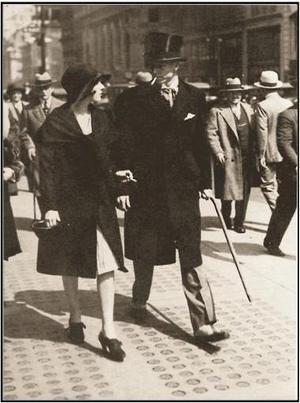
 [Photos via.]
[Photos via.]
The campaign was considered successful as sales to women increased afterward. Cigarette companies followed Bernays’s lead and created ad campaigns that targeted women. Lucky Brand Cigarettes capitalized on recent fashions for skinny women by telling women to “Reach for a Lucky instead of a sweet”:
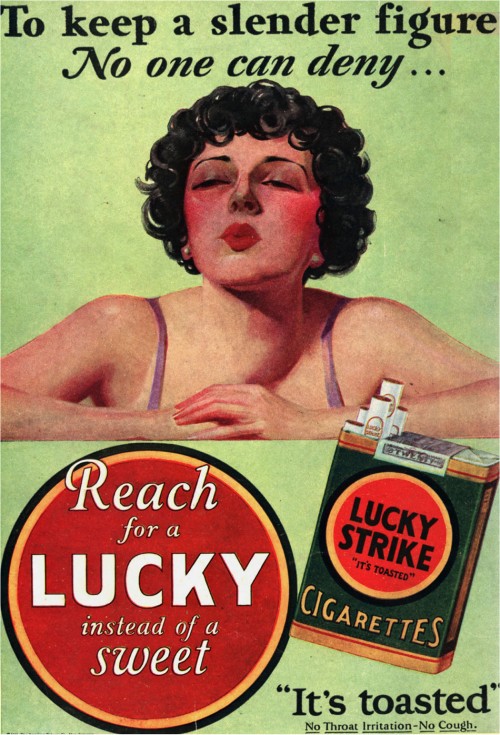
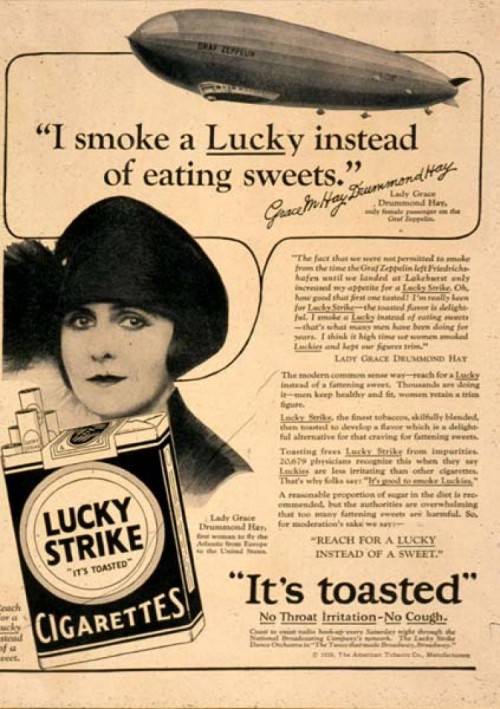
Marlboro, in stark contrast to the Marlboro Man ads we’re familiar with today, started the “Mild as May” campaign to encourage women to take up smoking cigarettes that were appropriately mild and easier to smoke:
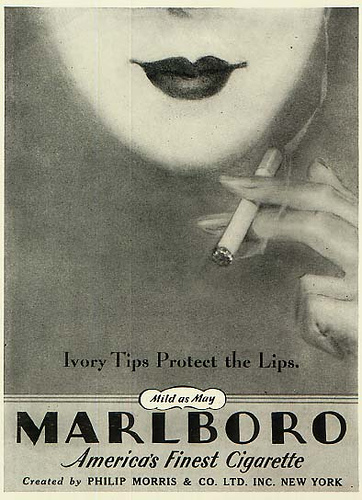
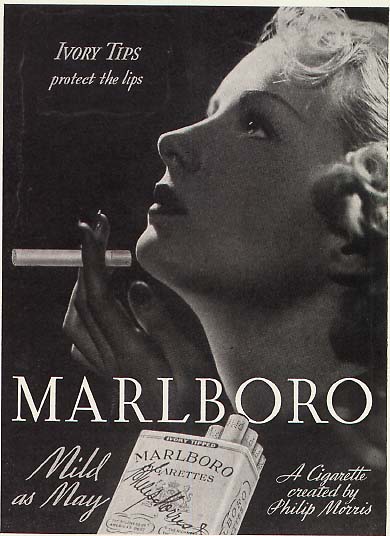
Chesterfield, in a 1930s ad, argued that “women started to smoke…just about the time they began to vote”:
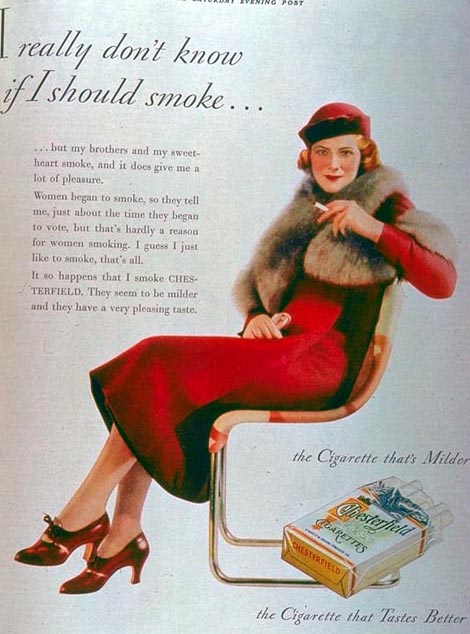
A later ad for Phillip Morris tells women to “Believe in yourself!”
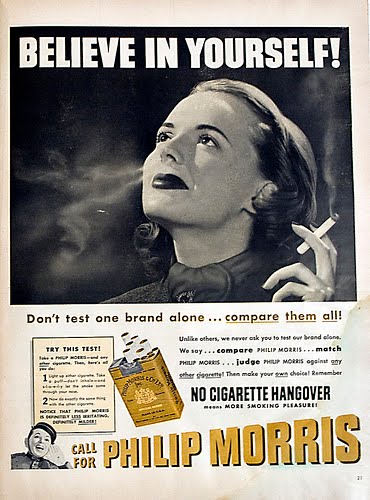
Cigarette makers also worked to teach women how to smoke properly. Ads often depicted women in the act of smoking. Some companies, like Philip Morris, even held smoking demonstrations for women:
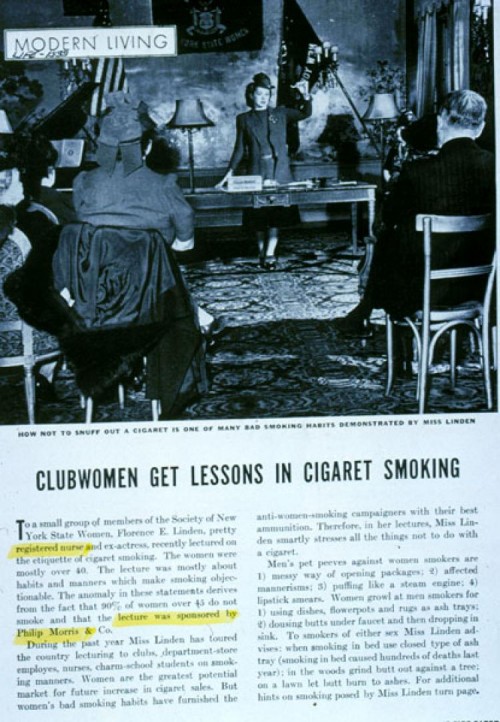 [Via.]
[Via.]
The article describes how a “pretty registered nurse” is touring the country to teach women proper smoking etiquette. The article also lists “men’s pet peeves” and “women’s pet peeves” for men and women smokers. (Full text after the jump below.)
Together, these efforts to conflate smoking with freedom and make smoking acceptable for women created a new set of consumers and reinforced Bernays’s argument that demand could be created.
Article Text:
To a small group of members of the Society of New York State Women, Florence E. Linden, pretty registered nurse and ex-actress, recently lectured on the etiquette of cigaret smoking. The women were mostly over 49. The lecture was mostly about habits and manners which make smoking objectionable. The anomaly in these statements derives from the fact that 99% of women over 45 do not smoke and that the lecture was sponsored by Philip Morris & Co. During the past year, Miss Linden ahs toured the country lecturing to clubs, department store employees, nurses, charm school students on smoking manners. Women are the greatest potential market for future increases in cigaret sales. But women’s bad smoking habits have furnished the anti-women-smoking campaigners with their best ammunition. Therefore, in her lectures, Miss Linden smartly stresses all the things not to do with a cigaret. Men’s pet peeves against women smokers are 1) messy ways of opening packages; 2) affected mannerisms; 3) puffing like a steam engine; 4) lipstick smears. Women growl at men smokers for 1) using dishes; 2) dousing butts under faucet and then dropping in sink. To smokers of either sex Miss Linden advises: when smoking in bed use closed type of ash tray (smoking in bed caused hundreds of deaths last year); in the woods grind butt out against tree; on lawn let butt burn to ashes; for additional hints on smoking posed by Miss Linden.

Comments 100
Matthew Coulter — February 27, 2012
If you like this article, check out BBC's Century of the Self to get a more detailed history of this event and other things Edward Bernays was involved in.
Karissa — February 27, 2012
Thank you for writing about this! A few years ago I was watching a tv show (I think it may have been Torchwood) and one of the female characters lit up a cigarette after sleeping with another woman. I was startled to notice that my immediate reaction to her smoking was to take it as evidence that she was a strong and independent woman. I don't smoke and I don't really like smoking in generally (although I don't try to stop people from doing it), yet I was experiencing feelings of approval at her perceived powerful womanhood.
Since then I have tried to pay attention to the portrayals of "strong women" (and also sometimes lesbian women, which is another interesting dynamic if you think of the cigarette as a phallic symbol) as "smoking women" in tv and movies. It seems like a fairly common occurrence to me, although I do not have any data on it to help me rule out the possibility of confirmation bias.
But anyway, I really appreciate the opportunity to place my idle observations in a historical context. And if any commenters post links to academic research on the subject of strong-women-smokers in popular culture, I will be very grateful!
christianrclarkson — February 27, 2012
Interesting that the men's 'pet peeves' were all about women failing to smoke properly while apparently women just hated men making a mess. Because obviously they'd be those ones cleaning up those dishes later!
LNel — February 29, 2012
I know I'm late on this post, but Bernays did not fabricate this idea out of thin air. In the 1900s, in particular pre-war Greenwich Village, rebellious women, many of whom called themselves feminists, consciously smoked in public as a protest of male dominated culture. "Proper" society from mid-town would travel to Greenwich Village to see these "emancipated women" smoking, and it was often written about in papers describing Village activity (often with shock and horror, and accompanied by descriptions of women's short hair and sandals, more concrete symbols of women's new freedom).
Prior to the 1920s smoking was quite literally a display of freedom for women, no conflation there. Cigarettes were a physical symbol of men's social power; women didn't smoke because they wanted a penis, they smoked to demonstrate that they could be, and were, socially equal to men. Bernays may have helped publicize this idea, but he certainly did not come up with it himself. The effect would not have been nearly as wide-spread had feminists and suffragists not already been using and popularizing cigarettes as a symbol of the new emancipated woman.
Women's desires to be equal to men was already, and necessarily, commodified. This is an example of companies co-opting what women were already doing.
Aa — March 2, 2012
The "Believe in Yourself" text looks so much like the text used on LOL Cats pictures that at first I thought it was a manipulated image.
john brown — March 4, 2012
Lippmann was not a member of the Committee on Public Information.
Marketing The Gap Between Intention And Action | Forbes — July 18, 2012
[...] call Dark Arts Marketing). Among other things, Bernays combined a campaign that helped make it socially excusable [...]
Marketing The Gap Between Intention And Action | Marketing — July 18, 2012
[...] call Dark Arts Marketing). Among other things, Bernays combined a campaign that helped make it socially excusable [...]
Marketing the Gap Between Intention and Action | Euro RSCG Prosumer Reports — July 19, 2012
[...] desires (what you might call Dark Arts Marketing). Among other things, Bernays created a campaign that helped make it socially acceptable for women to smoke by linking smoking to power and freedom [...]
Kryptonitezirconium7 — August 4, 2012
Everything liberal and leftist is just seduction that appeals to the pride of the minorities to corrupt and destroy them, and to destroy the majority groups though the minorities. This includes lesbianism, feminism, etc. It's time to lock and load, and form a millitia to execute governmental change. Together we can nail these sons of bitches who fucked both you and me, I'm counting on you buddy, don't let me down. We have the power! We can do it! Unimaginable wealth and social wellness is within reach, let us behave ourselves valiantly for our people and for our GOD.
Marketing the Gap Between Intention and Action – Euro RSCG Worldwide PR — August 20, 2012
[...] desires (what you might call Dark Arts Marketing). Among other things, Bernays created a campaign that helped make it socially acceptable for women to smoke by linking smoking to power and freedom [...]
TGC Podcast Episode 3: Why Should You Give A Damn About Love? The manipulation of our society away from love. | tgconnection | tgconnection — August 20, 2012
[...] http://thesocietypages.org/socimages/2012/02/27/torches-of-freedom-women-and-smoking-propaganda/ [...]
Women Didn’t Buy Smokes in the ’20s for the Same Reason People Don’t Buy Solar Power Today | Not a Punch Pulled — December 4, 2012
[...] Ed “figured it out,” or not is probably open to debate (something about penises). But what is unequivocally genius is what he did get women to start smoking (now keep in mind that [...]
Quick Hit: Living as a female smoker in Korea | The Grand Narrative — January 24, 2013
[...] Torches of Freedom: Women and Smoking Propaganda (Sociological [...]
Partie I- L’histoire de Coca-Cola, Levi’s et Lucky Strike depuis 1850. · tpelereveamericain — February 3, 2013
[...] http://thesocietypages.org/socimages/2012/02/27/torches-of-freedom-women-and-smoking-propaganda/ [...]
Women Didn’t Buy Smokes in the ’20s for the Same Reason People Don’t Buy Solar Power Today | The 60 Day MBA — March 3, 2013
[...] Ed “figured it out,” or not is probably open to debate (something about penises). But what is unequivocally genius is what he did get women to start smoking (now keep in mind that [...]
Se dietro il fumo delle femministe c’è Big Tobacco | GENDERmeria — May 31, 2013
[...] Ad avvertirli è stato Edward Bernays, lo stesso che ha convinto le suffragette ad accendere le “torce della libertà”. Nipote di Sigmund Freud e già consulente del comitato governativo sull’informazione pubblica, [...]
Public Relations Through Five Generations | Walek Alternative View — August 21, 2013
[...] The father of PR. Among other then-unprecedented ideas, he is famous for planning and executing the Torches of Freedom, a PR stunt where a group of women in New York City lit Lucky Strike cigarettes in front of [...]
Simbioza psihologije i odnosa s javnošću — November 3, 2013
[…] simbol emancipacije i ravnopravnosti s muškarcima u velikoj prosvjednoj paradi žena u New Yorku (Torches of Freedom Campaign). Žene su u paradi palile cigarete, dizale ih u zrak i nazivale ih bakljom slobode. Kada su se […]
BreakThru Radio — January 10, 2014
[…] to women. Since it was during the Women's Rights movement, he marketed the cigarettes as "Torches of Freedom." They weren't just consumable tobacco products; they represented an idea, and Bernays changed the […]
December Medland – Sign of the Times | splicedtogether 004 — March 12, 2014
[…] Women were encouraged to smoke to help them lose weight. Other smoking billboards offered ivory tips so their makeup wouldn’t be affected. (Source: Torches of Freedom) […]
Torch of Freedom or Torch of Disease and Death? How the Tobacco Industry exploited Womens Rights | The Great Tobacco Plague — April 6, 2014
[…] Philip Morris organised smoking lessons for women. Photo from http://thesocietypages.org/socimages/2012/02/27/torches-of-freedom-women-and-smoking-propaganda/ […]
I love guns - Page 7 — April 29, 2014
[…] […]
The Re-emergence of Storytelling in Content Marketing | Ingenuity Digital — May 16, 2014
[…] became “Torches of Freedom” signalling a woman’s defiance and her equal worth. Here Bernays used the power of storytelling […]
Comment on manipule les femmes avec des slogans féministes | Michelle Julien — May 30, 2014
[…] http://thesocietypages.org/socimages/2012/02/27/torches-of-freedom-women-and-smoking-propaganda/ […]
Greetings from Economies of Personal Data | Economies of Personal Information — June 5, 2014
[…] as psychoanalysis by his uncle Sigmund Freud. The most famous example being his campaign for “torches of freedom”. From Bernays came affective mass persuasion and the birth of the consumer culture. Consumer culture […]
SPACE: THE PHALLIC FRONTIER | DIY Leeds — November 10, 2014
[…] http://thesocietypages.org/socimages/2012/02/27/torches-of-freedom-women-and-smoking-propaganda/(2) […]
we are being led up the garden path my friends | Free Thinking Anarchist — January 18, 2015
[…] most notable achievement was in the 1920’s when he was hired by American Tobacco to devise a propaganda campaign to […]
Cito Kurrukan — February 3, 2015
I watched about this topic in Century of the Self on Youtube. Very interesting. And it reminds me of these cigarette ads.
The Intelligent Man's Guide to: Consumerism (Part 1: PR. . . — February 14, 2015
[…] credits: 1, 2, 3, 4, 5, […]
Reading Diary week 2 : Compromised fourth estate | OPEN YOUR MIND — March 24, 2015
[…] http://thesocietypages.org/socimages/2012/02/27/torches-of-freedom-women-and-smoking-propaganda/ […]
The Earliest PR Campaign- Module 2 | trentperriman — May 5, 2015
[…] Christensen, W 2012, ‘Torches of Freedom: Women and Smoking Propaganda’, viewed 28 April 2015, http://thesocietypages.org/socimages/2012/02/27/torches-of-freedom-women-and-smoking-propaganda/ […]
The world’s first PR Campaign – Torches of Freedom | gregoryvjohn — May 15, 2015
[…] Society Pages 2012, Christensen picture generator, digital image, viewed 1 April 2015, http://thesocietypages.org/socimages/2012/02/27/torches-of-freedom-women-and-smoking-propaganda/ […]
I'm A Woman And I Smoke. So What? — May 22, 2015
[…] propaganda, you'll understand how initially women who started smoking were actually lighting 'torches of freedom' as a sign of rebellion. Now, if you put A and B together, you'll realize how ignorant and […]
I’m A Woman And I Smoke. So What? - OddPad.com — May 22, 2015
[…] you’ll understand how initially women who started smoking were actually lighting ‘torches of freedom‘ as a sign of rebellion. Now, if you put A and B together, you’ll realize how ignorant […]
Capitalism will destroy the world, we must have co-operation, nor corporations | Fear and loathing in Great Britain — August 9, 2015
[…] http://thesocietypages.org/socimages/2012/02/27/torches-of-freedom-women-and-smoking-propaganda/ […]
A Note on Public Events and Propaganda | Orchestrated Pulse — August 10, 2015
[…] was all, of course, a spectacle paid for by the American Tobacco Company for the sole purpose of expanding their market. It was also a tremendously successful stunt that […]
Public Relations campaigns, research, the planning process | abouassy — August 21, 2015
[…] Christensen, W (2012), Torches of freedom: women and smoking propaganda. Sociological Images. Viewed on <20/08/15>. URL: http://thesocietypages.org/socimages/2012/02/27/torches-of-freedom-women-and-smoking-propaganda/ […]
The Internet Propaganda Machine | James Osiris Baldwin — August 21, 2015
[…] current form. Political parties, activist groups… anyone with the potential to hire people like Edward Bernays, considered to be the founding father of P.R – or ‘manufactured consent’. They don’t call P.R that any more, naturally – it smacks of […]
Barnum, Beranys and Debbie Sterling. | POSTMKTG — October 3, 2015
[…] of media manipulation for making bacon and eggs our national breakfast, making it okay for classy women to smoke and paving the way for the CIA to overthrow the ‘Communist’ government of […]
Why Anyone Who Questions the Safety of GMOs is Labeled Anti-Science | Natural Society — November 13, 2015
[…] [1] TheSocietyPages […]
Why Anyone Who Questions the Safety of GMOs is Labeled Anti-Science Dark Politricks — November 14, 2015
[…] [1] TheSocietyPages […]
HealthFreedoms – Why Anyone Who Questions the Safety of GMOs is Labeled Anti-Science — November 16, 2015
[…] [1] TheSocietyPages […]
Why Anyone Who Questions The Safety Of GMOs Is Labeled Anti-Science | Pure World Health — November 28, 2015
[…] [1] TheSocietyPages […]
Why Anyone Who Questions The Safety Of GMOs Is Labeled Anti-Science – The Truth May Scare You! — December 14, 2015
[…] [1] TheSocietyPages […]
“Group of girls puff at cigarettes as a gesture of freedom” – IsabellCQU — March 27, 2016
[…] Torches of Freedom: Women and Smoking Propaganda […]
Torches Of Freedom: 1929 PR Campagin – Jordan's Blog — April 9, 2016
[…] Society Pages. Torches of Freedom: Women and Smoking Propaganda. Author: Wendy Christensen (2012). https://thesocietypages.org/socimages/2012/02/27/torches-of-freedom-women-and-smoking-propaganda/ (Accessed […]
Film Club_The Century of the Self | Eunsung Choi's Blog — April 16, 2016
[…] Torches of Freedom [Photos via.] […]
COMM11110 – Torches of Freedom | shannonclarke97 — May 10, 2016
[…] Christensen, Torches of Freedom: Women and Smoking Propaganda, 27th February 2012, https://thesocietypages.org/socimages/2012/02/27/torches-of-freedom-women-and-smoking-propaganda/, Accessed […]
Three-Eyed Truths – – – ( E X ) E X E G E S I S – – — August 4, 2016
[…] kinds of notions that Bernays’ propagation has spawned – for a good example check out his ‘Torches of Freedom’ campaign – it’s another thing to recognise how we co-opt these manipulations, and through […]
EDWARD BERNAYS AND THE ENGINEERING OF CONSENT | Site Title — December 8, 2016
[…] https://thesocietypages.org/socimages/2012/02/27/torches-of-freedom-women-and-smoking-propaganda/ […]
From Saucepans to Cigarettes – The Vintage Blush — June 26, 2017
[…] hair and behaved in public. Shedding norms and over-coming social barriers led to the lighting of Torches of Freedom in […]
A Look Into The History And Effects Of Cigarette Advertisements (Revised) | Hannah Rines — November 29, 2017
[…] The Society Pages […]
My English Achivements — December 13, 2017
[…] Christensen, W. (2012). Torches of Freedom: Women and Smoking. Retrieved 26 November, 2017, from: https://thesocietypages.org/socimages/2012/02/27/torches-of-freedom-women-and-smoking-propaganda/ […]
Boss Babe Brands - Cannabis Packaging News — June 29, 2018
[…] https://thesocietypages.org/socimages/2012/02/27/torches-of-freedom-women-and-smoking-propaganda/ […]
Alfred Nobel and Posthumous Reputation Management – Character Assassination and Reputation Politics Research Lab — October 15, 2018
[…] early practices supporting corporate interests were often criticized. Bernays was instrumental in increasing sales of Lucky Strike cigarettes in the late 1920s among women who had formerly avoided smoking. Lee’s […]
101 – Introduction to fashion, media and marketing. – Adam Byrne FMM — November 6, 2018
[…] https://socialhistoryofspin.wordpress.com/top-8-observations-from-chapter-1/ https://thesocietypages.org/socimages/2012/02/27/torches-of-freedom-women-and-smoking-propaganda/ […]
YOU’VE COME A LONG WAY BABY: Exploited Feminism Within Vintage Cigarette Adverts – Ramona Magazine for Girls — January 21, 2019
[…] “Cigarettes were a symbol of the penis, and of male sexual power…Women would smoke because it w… […]
The link between gang stalking and prostitution: narrative control of women – Research and Data About Organized Gang Stalking, aka Police-Counter-Intelligence Stalking, aka Community Policing and Police Stalking — February 17, 2019
[…] Story: How Edward Bernay’s secular “cosmopolitan” Judaism used non-Jewish women as “Lib… to sell everything from vacuum cleaners to cigarettes; and to sell other “things” not […]
altes-gasthaus-hempelmann.de — April 26, 2019
Um mittels GPS die Katze zu orten, ist ein Sender und ein Empfänger nötig. Als GPS-Sender gilt ein Peilsender für Katzen. Der Empfänger ist ein Handy oder https://altes-gasthaus-hempelmann.de/
Mushrooms, Denver, and History | Dr. Desmond Wallington — May 5, 2019
[…] Since beginning their research into ethnomycology, the Wassons had two children Peter and Mary (Masha). Dr. Wasson wrote and published the popular children’s book, The Chosen Baby (1939), with Peter being the chosen baby in the book. The book was the first children’s book to address a taboo and difficult conversation for many adoptive parents. Gordon left journalism to take a position at J.P. Morgan as the Vice President of Public Relations, a pioneer in the banking industry leading to his friendship with Edward Bernays. Known as the “Father of Public relations,” Mr. Bernays popularized cigarette use with women drawing upon their feminist sensibilities by labeling them “Torches of Freedom.” […]
Gamblo — June 25, 2019
Bernays developed the theory of "market research" in 1896. His theory was developed using an experimental study of the marketing activities of newspapers to the community of New York City. The paper was edited with particular regard to the activities of the United States Army's General Newspaper, and in particular the Army magazine. As Bernays noted, some newspapers in the community had been published for the first time on the front in the United States Army. This newspaper was the "second best selling one in the country." https://gamblingtribe.com/ The two best-selling ones were, "The New York Herald Tribune" and "The City Herald." The latter one sold for "four times (the) average in New York City."
Semiyotik Pazarlama: Anlamlandıramadıklarımızdan mısınız? • Bigumigu — July 4, 2019
[…] örneklerden biri olan The Matrix serisi de Jean Baudrillard’ın eserinden esinlenilmişti. Freud’un yeğeni Edward Bernays ise Freud’dan öğrendiklerini iletişime uygulayarak bugünkü “Halkla İlişkiler” mefhumunu ortaya çıkardığını […]
Ulduar: Predictive Programming - Escape Samsara - Cell A208, Costa Rica — July 24, 2019
[…] For instance, Hegel believed in gradual reformation, instead of revolutions. To exemplify further, Edward Bernays advocated for people desiring or believing things they do not need. He was hired by tobacco […]
Sorry, But Smoking is Sexy - The Censored Mask — January 13, 2020
[…] Did you know that cigarettes played a major role in the women’s suffrage movement? That’s right, back in the day it was considered unladylike for women to smoke, so by sparking …. I mean, it wouldn’t be too hard to convince all of these hive-minded, 300-pound college […]
البروباغندا: أعظم مغامرات دعائية في التاريخ – El Jadida Place — February 9, 2020
[…] أبو العلاقات العامة أهمية الإيمان عندما عمل على حملة تسويقية لإحدى شركات التبغ، فقد ربط التدخين بقضية لها […]
The Psychology Of Business - Understanding The Buying Behaviour Of Your Customers - Potentash — February 15, 2020
[…] How does this tie in with business? Fred Sigmund claims that he used this psychoanalytic theory to manipulate people’s efforts without them realizing it. One such effort is getting women to smoke by equating smoking with challenging male power. You can read more about the ‘Torches of Freedom’ campaign here. […]
Linda lange — March 29, 2020
My grandmother was the Lucky Strike woman pictured " An ancient prejudice has been removed. I have a photo of her in the original oil painting that the ad came from.
Secrets Of The Society Shapers – The World We Live In — April 6, 2020
[…] train women to become smokers by linking the dirty habit with the women’s suffrage movement (here) — and who also trained many of us to crave “Bacon & Eggs” for breakfast […]
Dave Rubin — August 17, 2020
A DOPED UP CRIMINAL, WHO RESISTED ARREST AND DIED FROM A HEART ATTACK, BROUGHT ON BY DRUGS, BRINGS THE COUNTRY TO CHAOS!
A 5-YEAR-OLD CHILD IS EXECUTED, BY A SHOT TO THE HEAD, WHILE RIDING HIS BIKE, BRINGS OUT THE 3 MONKEY SYNDROME:
SEE NOTHING!
HEAR NOTHING!
SAY NOTHING!
What about CHILD LIVES MATTER?
Wrong Color!
DON'T LOOK FOR JUSTICE IN THIS BANANA REPUBLIC!
WHISTLE-BLOWER WILLIAM BINEY:
"My government that used to be a Constitutional Republic, we're not anymore"!
Understanding The Psychology Of Your Brand. | Trio Digital Marketing — October 19, 2020
[…] they don’t need by appealing to unconscious desires (to be free, to be successful, etc.). He was hired by the American Tobacco Company to encourage women to start smoking. While men smoked cigarettes, […]
How organized gang stalking undermines democracy – What is "organized gang stalking?" Research demonstrate that it is ALWAYS bizarre activity that involves police corruption — February 17, 2021
[…] PSYOPS at home and abroad ever since. Bernays, for example, famously organized white women by promoting cigarette smoking campaigns under the disguise of “women’s empowerment,”and like most of these toxic […]
La Pasqua è femmina! - Business4Women — March 31, 2021
[…] Mentre sgranocchi il tuo coniglietto di cioccolato ti racconterò la storia delle origini della Pasqua nelle civiltà pre-cristiane e i suoi bizzarri legami con il femminismo. […]
Your Sister — July 9, 2021
Cigarette as a phallic symbol? According to who exactly? "Penis envt" is a fabrication, and the only penis envy or worship comes from homosexuals (males).
Lesbian women generally have such all-consuming sexual episodes, they fall asleep, not reach for cigarettes. Lesbianism is not liberal or leftist, exactly the opposite. Actual lesbians are usually intellectuals who recognize the freedom afforded them by western civilization. You won't see genuine lesbians, for example, welcoming or even tolerating islam, with it's monstrous honor killings and female genital mutilation. This is all the fantasy of a degenerate jew like Freud, and the mindless throngs who swallow toxic prescriptions administered by his pseudoscientists.
Lesbians smoked because their experience bloomed within a bar culture, and anyone who's had more than enough to drink knows a cigarette can keep you from vomiting. Pair that with the fact young people always embrace what is fresh to their world. The last thing a programmed populace needs is to vilify those who are invisible allies.
#13 of Podcast: Political Boxes / Part 1 - Frieda Vizel — August 18, 2021
[…] #ARTICLE: Companies using the women’s suffrage movement to sell cigarettes. […]
The Secrets of the Society Shapers – The World We Live In — September 26, 2021
[…] train women to become smokers by linking the dirty habit with the women’s suffrage movement (here) — and who also trained many of us to crave “Bacon & Eggs” for […]
What’s the Difference Between Public Relations & Communications? » — March 24, 2022
[…] emotions amid the suffrage movement by declaring that cigarettes were the enlightened woman’s “torches of freedom.” By smoking in public, women were declaring themselves equal to […]
Trick of the Trade, but Not as Simple as it Looks - A Brief Look at Controversy as a Marketing Tactic – SMPLCTY — July 12, 2022
[…] American Tobacco Company’s (in)famous 1929 Torches of Freedom campaign – arguably the very first public relations campaign in the world that simultaneously […]
The Secrets of Societal Mind Control – The World We Live In — July 25, 2022
[…] train women to become smokers by linking the dirty habit with the women’s suffrage movement (here) — and who also trained many of us to crave “Bacon & Eggs” for […]
Trick of the Trade, but Not as Simple as it Looks – My Blog — September 2, 2022
[…] American Tobacco Company’s (in) famous 1929 Torches of Freedom campaign – arguably the very first public relations campaign in the world that simultaneously […]
A Day in School | Boyhood Recollections — September 6, 2022
[…] https://countercurrents.org/2018/05/from-bernays-to-trump-hooked-on-misery/ and: https://thesocietypages.org/socimages/2012/02/27/torches-of-freedom-women-and-smoking-propaganda/ Read: 16 April […]
Consumerism and Public Relations (PR) Campaigns Affect Us Deeply! - Salontity.com - Latest News — May 13, 2023
[…] Advertisements made by cigarette manufacturers to increase smoking among women in the 1920sThe Society Pages […]
Pohdiskelua meikkaamisen normista – Radikaalifeminismi — June 10, 2023
[…] sovinnaista feminiinisyyden normia. Näkemys on heppoinen ja tuo mieleen, kuinka 1920-luvulla mainosmiehet keksivät hyödyntää feminismiä tupakkamainoksissa. Nainen savuke kädessään näet ilmentäisi […]
أعلى 10 نسب مدخنات في العالم - انا مسافر — July 2, 2023
[…] الشركات ذلك من خلال ربط التدخين بالحرية والتمرد على المجتمع ‘الذكوري” بعد نهاية الحرب العالمية الأولى في ما عُرف تاريخيًا […]
أعلى 10 نسب مدخنات في العالم - انا مسافر — July 6, 2023
[…] الشركات ذلك من خلال ربط التدخين بالحرية والتمرد على المجتمع “الذكوري” بعد نهاية الحرب العالمية الأولى في ما عُرف تاريخيًا […]
Tricked (again) – Timothy P. Lofton — September 15, 2023
[…] More: Gas, Diamonds, The Easter Parade […]
Tricked (again) – Shawn Nutley | Kelowna Entrepreneur — September 15, 2023
[…] More: Gas, Diamonds, The Easter Parade […]
Tricked (again) - CraftYourAds — September 15, 2023
[…] More: Gas, Diamonds, The Easter Parade […]
Tricked (again) | Seth's Blog - Improveology.biz — September 15, 2023
[…] More: Gas, Diamonds, The Easter Parade […]
Tricked (once more) | Seth’s Weblog – Webbizmarket.com — September 15, 2023
[…] Extra: Fuel, Diamonds, The Easter Parade […]
Tricked (once more) | Seth’s Weblog - Younicheblogs.com — September 15, 2023
[…] Extra: Gasoline, Diamonds, The Easter Parade […]
Tricked (again) | Seth’s Blog – Freelancer themes temple — September 16, 2023
[…] More: Gas, Diamonds, The Easter Parade […]
Dupé (encore) | Le blog de Set Réécriture : Dupé (encore une fois) | Le blog de Set - Tumely — September 17, 2023
[…] De plus: Gaz, Diamants, Le défilé de Pâques […]
Nick — February 14, 2024
Ladies, elevate your vaping experience with Shop Top Vape Brands. Discover a world where elegance meets functionality, offering a curated selection of high-quality, stylish vape devices tailored for the modern woman. From sleek, discreet pens to flavorful e-liquids, find everything you need at competitive prices. Embrace a lifestyle of sophistication and satisfaction with our premium vaping solutions. Your perfect vape awaits – explore our collection today and find your match.